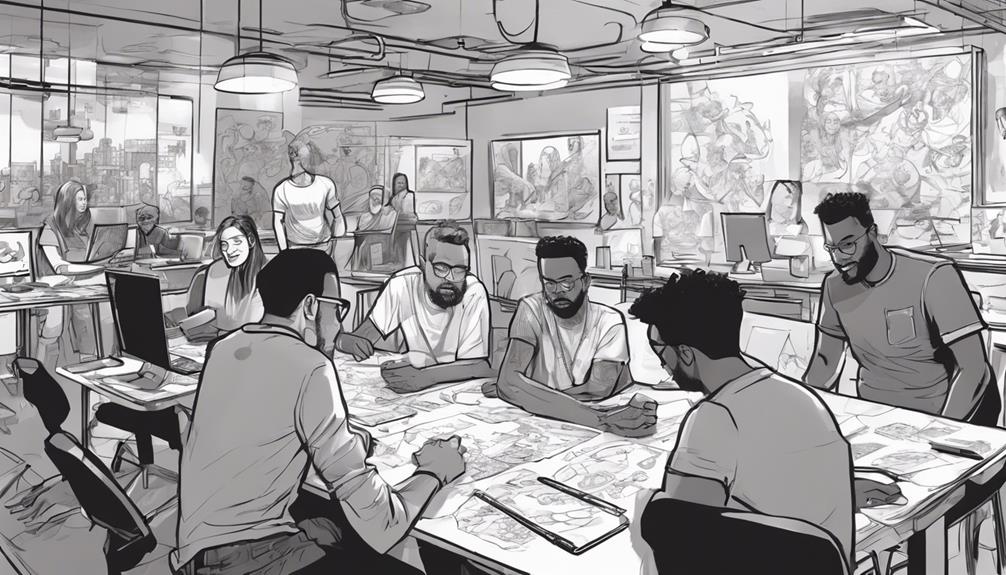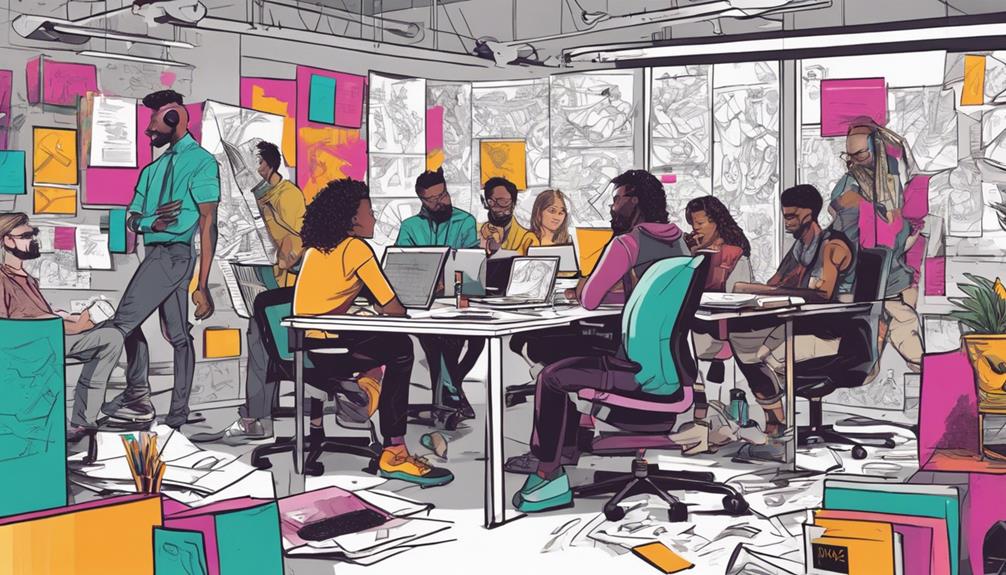Design thinking transforms problem-solving by focusing on user needs. It kicks off with empathy to truly understand users. Then, ideas are brainstormed, prototypes are made, and testing refines solutions. This method encourages constant improvement. If you want to know more, the complete process will make sense.
Key Takeaways
- Problem-solving approach centered on human needs.
- Prioritizes user-centric solutions.
- Empathy-driven methodology for innovation.
- Involves ideation, prototyping, and testing phases.
- Cultivates a culture of continuous improvement.
Overview of Design Thinking
Design thinking is a problem-solving approach anchored in human-centered design principles. It prioritizes solutions that cater to the needs of the end user, addressing problems through innovation and user-centricity. The methodology starts by establishing empathy with users, delving deep into their needs and challenges. Moving through defined phases like ideation, prototyping, and testing, design thinking ensures solutions are theoretically sound, practically feasible, and user-approved. By emphasizing creative problem-solving, it fosters a culture of continuous improvement and iteration. Through this structured process, ideas are refined, and prototypes are tested to deliver outcomes that resonate with the end user.
Design thinking is not just about coming up with any solution; it's about crafting solutions that truly make a positive impact in the lives of those they're designed for.
Phases of Innovation

Throughout the process of innovation in design thinking, you navigate through distinct phases that guide you from problem clarification to solution implementation. Design thinking emphasizes user-centricity and human-centered design, ensuring that the solutions developed address the actual needs of the users.
The iterative nature of design thinking allows for continuous refinement of solutions through prototyping and testing, enabling teams to iterate and improve based on user feedback. This iterative approach also helps in tackling complex problems by breaking them down into manageable steps and testing potential solutions.
- Problem Clarification: Identify and understand the user's needs and pain points.
- Ideation: Generate a wide range of possible solutions to address the identified problems.
- Prototyping: Create tangible representations of the proposed solutions for testing and feedback.
- Implementation and Iteration: Implement the solution, gather feedback, and continuously refine based on user input.
Importance of Design Thinking Skills

Having a strong foundation in design thinking skills can greatly enhance your career prospects and earning potential. Design thinking skills are highly sought after in today's job market due to their role in the innovation process and developing efficient solutions. Businesses are actively looking for individuals with these skills, leading to increased job opportunities and career advancement possibilities. Occupations like marketing managers and software developers, which require design thinking skills, tend to offer higher salaries, indicating the importance of these skills in boosting earning potential. By developing your design thinking skills, you not only become more valuable to employers in terms of talent acquisition but also position yourself for higher salaries and career growth opportunities.
| Importance of Design Thinking Skills | Benefits |
|---|---|
| Higher Salaries | Increased Job Opportunities |
| Career Advancement | Business Demand |
| Efficient Solutions | Talent Acquisition |
| Developing New Solutions | Salary Potential |
Learning and Applying Design Thinking
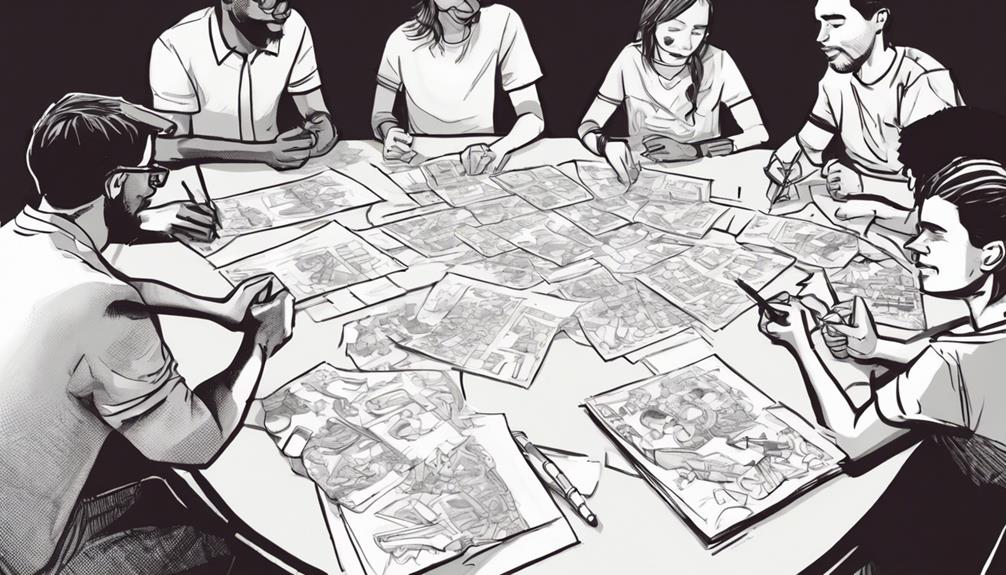
You're about to explore how learning and applying design thinking can equip you with valuable skills that lead to career advancement opportunities.
By understanding the principles of design thinking, you can enhance your problem-solving abilities and create user-centric solutions in various industries.
Embracing design thinking can open doors to higher salaries and increased demand for your expertise in today's competitive job market.
Skills for Application
Developing proficiency in applying design thinking techniques can greatly enhance your problem-solving abilities and boost your career prospects. When it comes to mastering design thinking skills, here are some key areas to focus on:
- User Research: Conduct thorough research to understand the needs and preferences of the target audience.
- Idea Generation: Engage in the ideation phase to brainstorm and explore a wide range of innovative solutions.
- Prototyping and Testing: Create prototypes to test ideas and gather valuable user feedback for refinement.
- Problem-Solving: Utilize the design thinking process to define the problem statement, empathize with users, and generate creative solutions.
Career Advancement Opportunities
To advance your career prospects and increase your earning potential, mastering design thinking skills is becoming increasingly essential in today's competitive job market. Jobs that require design thinking skills often offer higher salaries, highlighting the value placed on innovative problem-solving approaches.
By learning and applying design thinking, you can drive innovation within your workplace and open up new opportunities for career advancement.
The demand for professionals with design thinking skills is evident in the rise of job postings seeking individuals adept at this problem-solving approach. Businesses recognize the importance of incorporating design thinking into their processes to stay competitive and meet evolving customer needs.
This recognition creates more avenues for individuals with these skills to showcase their ability to think creatively and solve complex problems effectively.
Embracing design thinking not only enhances your skill set but also positions you as a valuable asset in today's rapidly changing job market, where innovation is key to success.
Considerations and Skills
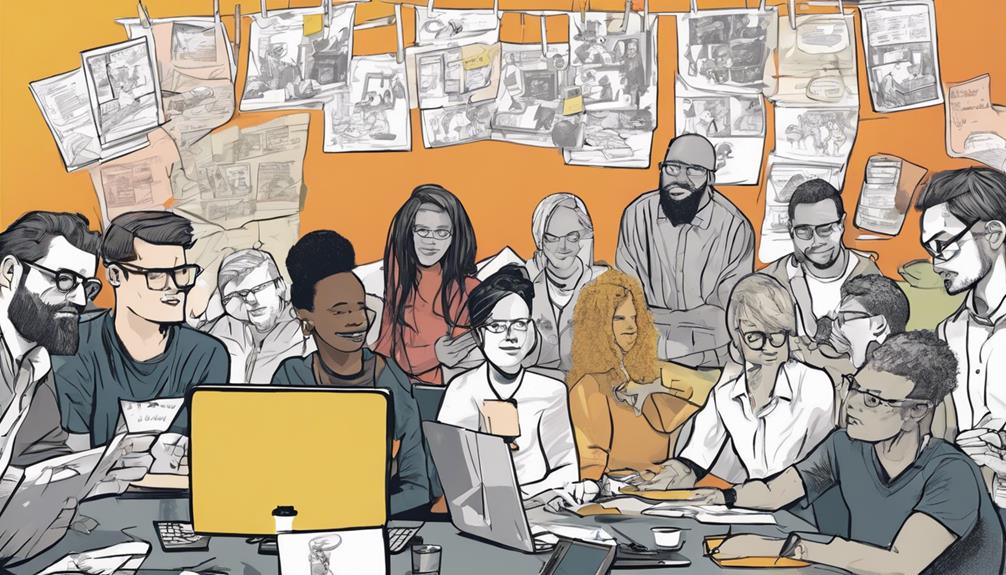
You should consider the fundamental skills required for success in design thinking.
Reflect on your goals and motivations while evaluating additional capabilities needed to excel in this field.
Communication, innovation, leadership, research, and management skills are vital for mastering design thinking.
Skills for Success
Consider incorporating additional skills such as agile methodology, user experience design, prototyping, product management, and strategic planning to enhance your success in design thinking. These skills play an essential role in shaping your approach and problem-solving abilities within the design thinking framework.
Here are some essential skills to focus on:
- Agile Methodology: Embrace a flexible and iterative approach to project management.
- User Experience Design: Prioritize creating meaningful and user-centric design solutions.
- Prototyping: Develop quick and tangible representations of your ideas for testing and validation.
- Product Management: Master the skills needed to bring a product from conception to market successfully.
Essential Considerations
When exploring important considerations for design thinking, prioritize incorporating additional skills like agile methodology, user experience design, and strategic planning. These skills complement the design thinking approach by fostering a deeper understanding of user experience, enhancing problem-solving capabilities, and promoting innovation.
Before diving into design thinking, reflect on your personal goals and motivations to guarantee alignment with your career objectives. Communication, innovation, leadership, and management capabilities are vital for success in applying design thinking effectively.
Additionally, assess job requirements and professional profiles to tailor your design thinking skills for specific roles and industries. Recognize the increasing demand for design thinking skills in various job postings across industries as a pathway for career advancement.
What Is Design Thinking (Dt)?
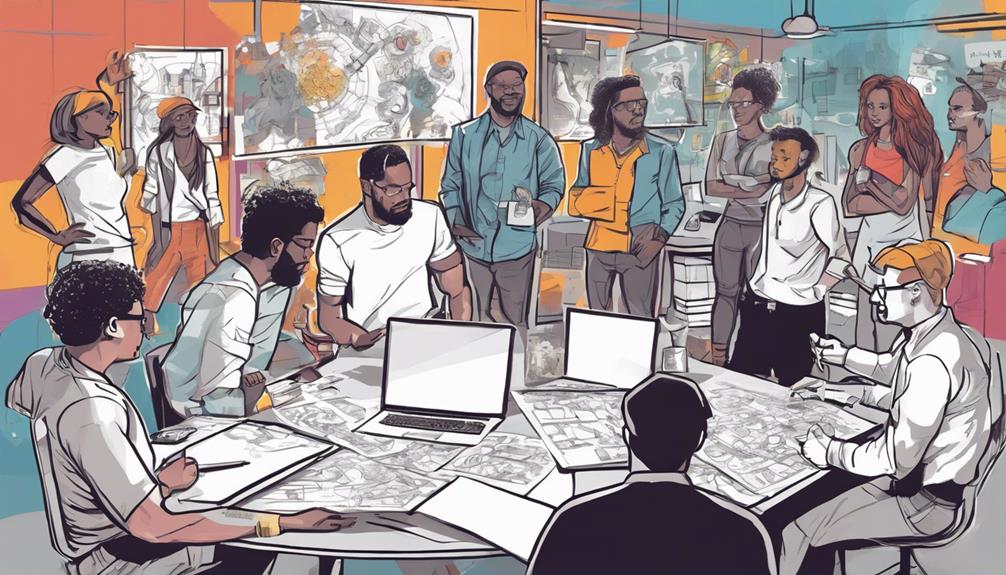
Design thinking, also known as Dt, is a dynamic process used to understand users and develop innovative solutions through iterative steps.
When engaging in design thinking, the design process starts by empathizing with users to gain insights into their needs and challenges.
The next phase, the define phase, involves synthesizing observations to define a clear problem statement.
Subsequently, ideation sessions are conducted to generate a wide range of innovative ideas to address the identified problems. This process allows for a creative exploration of potential solutions that may not be immediately obvious.
Why Design Thinking Is Important

Embracing design thinking is crucial for unlocking innovation and maintaining a competitive edge in today's dynamic market landscape. In the domain of business, design thinking plays a pivotal role in understanding user needs by engaging cross-functional teams. This collaborative approach ensures that solutions aren't only innovative but also resonate with the end-users.
Companies such as Google, Apple, and Airbnb have effectively utilized design thinking to drive successful innovations and tackle complex challenges in competitive markets. Design thinking offers a structured framework to address challenging problems, encouraging the generation of creative solutions that traditional problem-solving methods might overlook. Its practical methods and tools can be applied across diverse and intricate industries, making it a versatile approach for organizations seeking to stay ahead in an ever-evolving business environment.
The End Goal of Design Thinking

To accomplish the end goal of design thinking, teams prioritize creating solutions that are appealing, achievable, and profitable.
- Appealing: Teams focus on comprehending the needs of end users to secure that the solutions meet their requirements and provide value.
- Achievable: After identifying appealing solutions, teams assess whether they've the necessary resources and capabilities to implement them effectively.
- Profitable: Apart from being appealing and achievable, solutions must also be profitable for the organization to guarantee long-term sustainability and success.
- Comprehending: Design thinking emphasizes a deep understanding of users' needs and challenges, driving innovation and creating solutions that truly make a difference.
The Five Stages of Design Thinking

Throughout the design thinking process, you engage in a journey through five key stages that guide you from understanding user needs to testing and refining solutions. The first stage, Empathize, focuses on gaining an understanding of user needs through empathy. In the Define stage, you create a problem statement that will guide the Ideate stage in generating innovative solutions. Ideation leads to the development of a wide range of ideas that are then narrowed down and transformed into prototypes in the Prototype stage. Finally, in the Test stage, these prototypes are tested with users to gather iterative feedback and verify that the solutions meet user requirements. Remember, these stages are not always linear and can be revisited or worked on simultaneously. Check out the table below for a quick overview of the five stages of design thinking:
| Stage | Description | Key Focus |
|---|---|---|
| Empathize | Understanding user needs through empathy | User needs |
| Define | Creating a problem statement for Ideation | Problem statement |
| Ideate | Generating a wide range of solutions | Ideation |
| Prototype | Developing prototypes based on selected solutions | Prototyping |
| Test | Testing prototypes with users for iterative feedback | User requirements |
Frequently Asked Questions
What Are the 5 Points of Design Thinking?
To understand design thinking, remember the 5 points: Empathize, Define, Ideate, Prototype, and Test. These steps help you create user-centered solutions by gaining insights, defining problems, generating ideas, building prototypes, and testing iteratively.
What Is Everything About Design Thinking?
Discover the depths of design thinking, where creativity reigns and innovation thrives. Uncover user needs, craft clever solutions, and test with precision. Engage in empathy, define, ideate, prototype, and test for success.
What Is the Main Focus of Design Thinking?
In design thinking, the main focus is on understanding users deeply, empathizing with their perspectives, and addressing their unmet needs. It encourages collaboration, idea generation, prototyping, and testing with real users for effective solutions.
What Are the 3 Key Concepts of Design Thinking?
When diving into design thinking, remember the trio: desirability, feasibility, and viability. They guide you towards crafting solutions that truly connect with users, can be brought to life, and make business sense.
Conclusion
So there you have it – design thinking is like a creative puzzle that helps you discover innovative solutions to complex problems.
By embracing this approach, you can navigate through the maze of challenges with ease, seeing the bigger picture and connecting the dots in a way that sparks new ideas and possibilities.
Keep honing your design thinking skills and watch as you transform ordinary problems into extraordinary opportunities!

